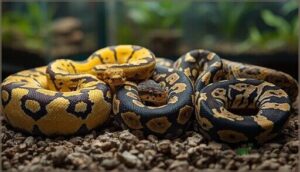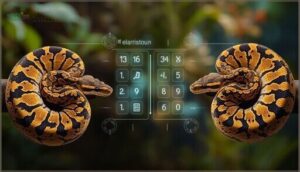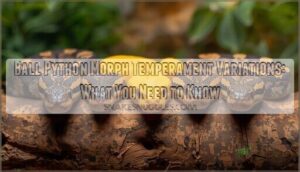This site is supported by our readers. We may earn a commission, at no cost to you, if you purchase through links.
You can pair a pastel ball python with a pinstripe and produce everything from normal-looking hatchlings to stunning banana combos—or you can know exactly what you’re working with before a single egg drops. A ball python genetics calculator for morphs takes the guesswork out of breeding by mapping every possible outcome before you commit to a pairing.
These digital tools translate complex Mendelian inheritance patterns into visual predictions, showing you the probability of each morph appearing in your clutch.
Whether you’re planning your first breeding project or refining a multi-gene strategy, understanding how these calculators work transforms breeding from educated guessing into informed decision-making.
Table Of Contents
- Key Takeaways
- What is a Ball Python Genetics Calculator?
- Basic Genetics of Ball Python Morphs
- How Genetics Calculators Predict Morph Outcomes
- Using a Ball Python Morph Calculator Step-by-Step
- Advanced Applications for Breeding Projects
- Frequently Asked Questions (FAQs)
- What is the Morph Ball Python calculator?
- What is the ball python genetic calculator?
- What is the basic genetics of Ball Pythons?
- How does a genetic morph calculator work?
- What traits are included in the morph market calculator?
- What genes produce the rarest ball python morphs?
- Can inbreeding affect ball python morph quality?
- How do recessive genes skip generations visually?
- Which morph combinations create the highest value offspring?
- Do calculators account for line-bred trait variations?
- Conclusion
Key Takeaways
- Ball python genetics calculators translate complex Mendelian inheritance patterns into visual predictions, removing guesswork by mapping every possible morph outcome and probability before you commit to a breeding pairing.
- Understanding the distinction between dominant, recessive, and co-dominant traits is essential—dominant genes express immediately, recessive traits need two copies to appear, and co-dominant genes create unique “super” forms that shape your breeding strategy.
- Advanced calculator applications enable multi-gene pairing strategies, genetic diversity tracking, and economic forecasting by translating phenotype probabilities into real profit margins, with rare combinations commanding prices exceeding $2,750 per offspring.
- These tools don’t guarantee results but transform breeding from educated guessing into calculated risk management, allowing you to weigh odds, recognize patterns, and anticipate challenges before eggs hatch.
What is a Ball Python Genetics Calculator?
A ball python genetics calculator is designed to help you predict the potential outcomes of different breeding pairings. It pulls together the genetic information from each parent and shows you what to expect in your clutch.
Here’s what you’ll usually find when you use one of these tools.
Definition and Purpose
Every worthwhile breeding project starts with clarity, and that’s just what a Ball Python Genetics Calculator brings to your table. By weaving together Calculator Origins and the logic of genetic calculator algorithms, it helps you pinpoint genetic outcome prediction, translating your goals into practical forecasts grounded in Ball Python genetics. The calculator is based on Mendelian genetics principles.
- Calculates genetic probabilities for targeted morphs
- Predicts offspring appearance using genetic codes
- Clarifies potential risks—essential for ethical considerations
- Simplifies genetic education with visual genotype results
- Aids economic forecasting for future breeding plans
Benefits for Breeders and Hobbyists
With a snake breeding calculator, you refine Breeding Efficiency, sharpen genetic outcome prediction, and boost Economic Advantages by forecasting market-ready Ball Python morphs. The Morph Ball Python Calculator also aids Genetic Diversity, letting you plan healthy pairings.
These tools help breeders understand basic genetic principles to predict offspring traits. Educational Benefits and Community Engagement grow as you share results, learn new strategies, and connect with fellow breeders—all while improving your genetic probabilities.
Common Features and Tools
A Ball Python Genetic Calculator offers mobile accessibility, autocomplete search for morph selection, and interactive tables for instant results. Visual confirmation through morph images, cloud integration for pedigree tracking, and the ability to handle complex interactions make these tools indispensable.
Whether you’re using a snake breeding calculator or Morph Ball Python Calculator, you’ll simplify planning and boost accuracy.
Basic Genetics of Ball Python Morphs
Understanding the basics of ball python genetics is the key to predicting morph outcomes with confidence. You’ll need to get familiar with a few important terms and concepts before pairing snakes.
Here’s what you should know as you look at the main genetic traits and morph examples.
Key Genetic Terms and Concepts
Ever wonder how a handful of genes can shape a ball python’s look? You’ll need to grasp chromosomal concepts—alleles, genotype versus phenotype, and how Punnett Squares map outcomes.
Terms like heterozygous carriers, simple recessive, double recessive, and homozygous genes aren’t just vocabulary; they’re the backbone of genetics, guiding your breeding strategy and predicting morph possibilities.
Dominant, Recessive, and Co-Dominant Traits
Inheritance patterns in Ball Python genetics hinge on three core categories: Dominant, Recessive, and CoDominant traits. Dominant genes show immediate visual expression, while Recessive traits require two copies to appear. CoDominant genes create unique “super” forms.
Understanding these distinctions shapes your breeding strategies, informs genetic combinations, and helps you leverage a genetic calculator to estimate market value and predict outcomes.
Common Ball Python Morph Examples
Color and pattern diversity in Ball Python morphs illustrates how genotype shapes phenotype. To master genetic calculator predictions, focus on four iconic examples:
- Albino genetics—yellow bodies, recessive trait.
- Banana variations—codominant, freckled patterns.
- BEL combinations—blue-eyed leucistics, multi-gene origins.
- Spider controversy—dominant gene, unique web-like patterns, ethical debate.
Each morph offers distinct breeding potential.
How Genetics Calculators Predict Morph Outcomes
When you use a genetics calculator, the process starts with entering the genes of your parent snakes. The tool then works through the probabilities to predict which morphs could appear in the offspring.
Here’s how each step fits together.
Inputting Parent Morphs and Genes
You know, accuracy in Morph Identification starts at the keyboard—typing a base gene name, double-checking Gene Zygosity, and handling Data Formats with care.
Whether you’re selecting genes for complex combinations or verifying morph names, a genetic calculator thrives on precise input.
That’s why accuracy verification isn’t just a step; it’s the backbone of reliable gene selection and outcome prediction.
Punnett Squares and Probability Calculations
Picture a Punnett Square as your genetic map—each box revealing genotype probabilities and guiding your breeding expectations. Probability calculations clarify how phenotype ratios emerge, especially in dihybrid crosses.
Keep in mind:
- Linked genes may skew results due to linkage disequilibrium
- Dominant traits often mask recessive ones in phenotype expression
- Statistical outcomes guide, but never guarantee, real clutch results
Understanding Genotype to Phenotype Results
Ever wonder why two identical-looking ball pythons can produce wildly different offspring? Genotype to phenotype isn’t always a straight line—modifier genes and environmental influence shape phenotype variability. Predicting morph outcomes means factoring in mutation effects and genetic background.
Identical-looking ball pythons can yield wildly different offspring because genotype-to-phenotype expression depends on modifier genes, environment, and genetic background—not just visible traits
Here’s a breakdown:
| Genotype Prediction | Phenotype Expression | Modifier Genes |
|---|---|---|
| High accuracy | Variable | Significant |
| Simple traits | Consistent | Minimal |
| Complex crosses | Unpredictable | Major impact |
Using a Ball Python Morph Calculator Step-by-Step
Getting started with a ball python morph calculator is easier than you might think.
You’ll want to know how to select genes, enter them correctly, and read the results.
Here’s how each step works.
Selecting Male and Female Genes
Once you’ve chosen your breeding project, you need to input each parent’s genes to generate accurate predictions. This step reveals the calculator’s full potential, showing which genotype and phenotype combinations your pairing can produce.
Here’s what you should consider when selecting genes:
- Male Maturity: Males generally reach breeding readiness at 16–18 months, influencing your timing
- Female Maturity: Females mature later, around 27–31 months, affecting project planning
- Maker Status: In morphs like Banana, males often produce sex-skewed offspring ratios
- Gene Combinations: Pairing heterozygous traits strategically increases desirable morph frequencies
- Genetic Diversity: Choosing unrelated parents maintains healthy bloodlines and vigor
Understanding both parents’ genetic contributions helps you optimize morph outcomes while preserving population health.
Formatting and Data Entry Tips
After you’ve selected your parent snakes, accurate data entry becomes your next priority. Standardize morph name format to match the calculator’s database exactly—capitalization and spacing matter.
Input genetic symbol information carefully, distinguishing het from homozygous states to guarantee precise genetic probabilities. Follow the tool’s data entry order, using drop-downs when available to avoid typos.
Complex morph combinations require special attention to genotype specifications, directly affecting predicted phenotype outcomes and overall genetic outcomes accuracy.
Interpreting Predicted Offspring Results
Once you’ve entered your data, the calculator displays morph outcomes through probability percentages and visual tables. You’ll see phenotype vs genotype distinctions—carriers versus visual morphs—alongside specific offspring compositions.
These phenotype predictions guide breeding decisions, though accuracy limitations exist with complex pairings. Understanding probability percentages helps you anticipate genetic outcomes realistically, turning predicted morph outcomes into actionable breeding strategies that balance desired traits with market considerations.
Advanced Applications for Breeding Projects
Once you’ve mastered the basics of genetic calculators, you can push them further to plan more ambitious breeding projects. These tools become especially valuable when you’re juggling multiple genes, tracking lineage details, or evaluating which pairings make the most financial sense.
Here’s how you can apply calculators to take your breeding strategy to the next level.
Planning Multi-Gene Pairings
When you’re stacking multiple genes in a single pairing, genetic probability calculation becomes essential. Modern calculators handle complex Punnett square applications to predict gene combinations, identifying lethal gene avoidance opportunities before you commit.
You’ll manage heterozygosity more effectively while anticipating phenotype unpredictability.
MultiGene projects demand careful planning to reduce inbreeding risk, ensuring your outcomes match expectations while calculating genetic outcomes with precision.
Tracking Genetic Diversity and Zygosity
Beyond prediction, calculators support data management to monitor heterozygosity levels and allelic variation over time. You’ll track zygosity outcomes—distinguishing homozygous from heterozygous genotypes—while documenting phenotype-genotype correlations.
Maintaining heterozygosity above 60% minimizes inbreeding impact, preserving genetic variation across your collection. Recording alleles and parentage lets you audit breeding decisions, ensuring your project sustains diversity while achieving targeted morph goals with confidence.
Assessing Economic Value of Morph Outcomes
Calculators let you translate genetic outcome probabilities into real-world profit margins by matching phenotypes to current market values. Understanding morph rarity, market saturation, and demand influence helps you forecast breeding profitability before committing resources.
Key factors shaping value retention include:
- Initial rarity and visual appeal of morphs
- Market saturation from competing breeders
- Multi-gene combinations commanding premiums
- Age and breeding readiness of offspring
- Industry-wide demand cycles and trends
Prices for common morphs start near $40, while rare genetic calculator applications reveal pairings that yield offspring worth $2,750 or more, allowing strategic project planning.
Frequently Asked Questions (FAQs)
What is the Morph Ball Python calculator?
Think of it as a crystal ball for breeding—the Morph Ball Python Calculator predicts offspring genetics with impressive calculator accuracy, helping you visualize morph outcomes before pairing your snakes together.
What is the ball python genetic calculator?
A ball python genetic calculator is a breeding tool that predicts offspring morphs by applying genetic principles to parent genes, calculating genetic probabilities for dominant, recessive, and co-dominant traits in snake breeding projects.
What is the basic genetics of Ball Pythons?
Genes exist in pairs—one allele from each parent—determining your ball python’s morph.
Genetic traits follow Mendelian ratios through dominant, recessive, or co-dominant inheritance patterns, creating phenotype diversity from simple genotype combinations.
How does a genetic morph calculator work?
You enter parent genes into a Punnett square-based calculator that applies Mendelian probability basics to predict genetic outcomes. The algorithm translates genotype data into phenotype predictions, enabling strategic breeding decisions through precise calculation mechanics.
What traits are included in the morph market calculator?
Like the periodic table organizing elements, the MorphMarket calculator maps over 210 ball python morphs—dominant, codominant, and recessive traits—plus allelic complexes and polygenic variations, enabling precise offspring outcome predictions across genotypes and phenotypes.
What genes produce the rarest ball python morphs?
The rarest ball python morphs emerge from recessive alleles like Lavender Albino’s OCA2 deletion, or multi-gene complexes producing Blue-Eyed Leucistics.
Breeding odds for triple-recessive phenotypes drop below 56%, driving extreme market scarcity.
Can inbreeding affect ball python morph quality?
Yes, inbreeding severely compromises morph quality. You’ll see defect incidence reach 15–60%, reduced neonatal survival rates, genetic diversity loss, and poor phenotype expression.
Welfare outcomes decline as harmful genetic traits accumulate across generations.
How do recessive genes skip generations visually?
A breeder pairs two normal-looking snakes carrying hidden albino genes. Surprisingly, 25% of their clutch shows bright albino coloration.
Recessive genes remain invisible in het carriers until both parents contribute matching alleles, revealing the phenotype only when genotype aligns homozygously.
Which morph combinations create the highest value offspring?
Multi-gene projects pairing recessive morphs like Clown or Puzzle with co-dominant genes such as Mojave or Leopard generate high-demand offspring.
Rare gene combos and phenotype quality drive investment breeding value and strong morph market trends.
Do calculators account for line-bred trait variations?
Most genetics calculators rely on simple Mendelian models and don’t incorporate polygenic inheritance or modifier gene effects common in line-bred variations.
Calculator accuracy drops when breeding strategies involve complex, line-specific traits requiring emerging tools.
Conclusion
The best breeding decisions emerge not from certainty, but from understanding probability. A ball python genetics calculator for morphs doesn’t guarantee results—it allows you to weigh odds, recognize patterns, and anticipate challenges before they hatch.
Each pairing becomes less about chance and more about calculated risk. You’re not predicting the future; you’re mapping the genetic landscape.
Master these tools, and you’ll transform enthusiasm into expertise, turning every clutch into a deliberate step toward your breeding vision.
- https://faunaclassifieds.com/forums/threads/new-mobile-friendly-ball-python-morph-calculator.550886/
- https://ball-labs.ueniweb.com/blog/understanding-ball-python-genetics-and-morphs
- https://www.biorxiv.org/content/10.1101/2021.05.19.444867v2.full.pdf
- https://www.accio.com/business/cheap-ball-python-morphs
- https://www.facebook.com/groups/967708664967231/posts/1258785889192839/













